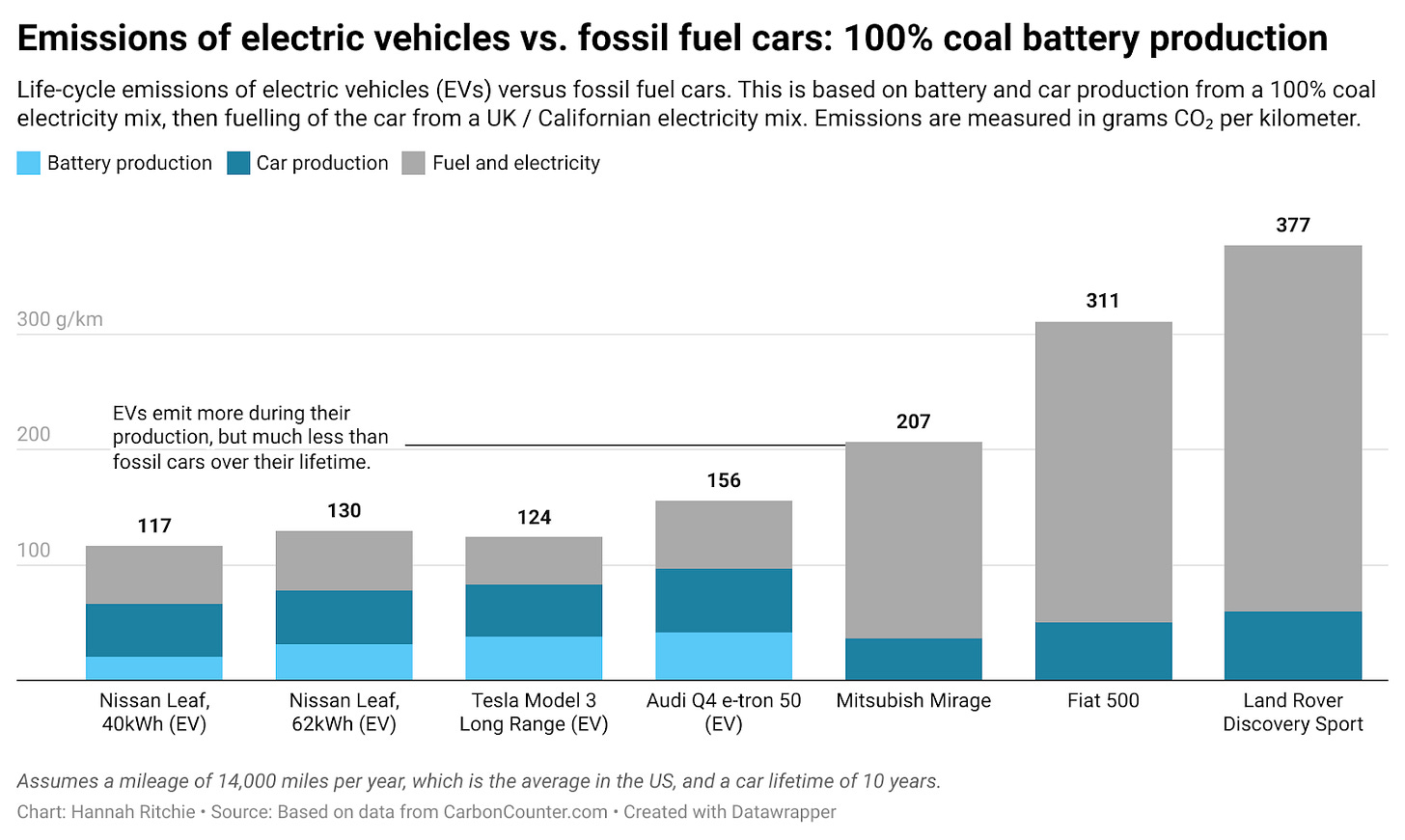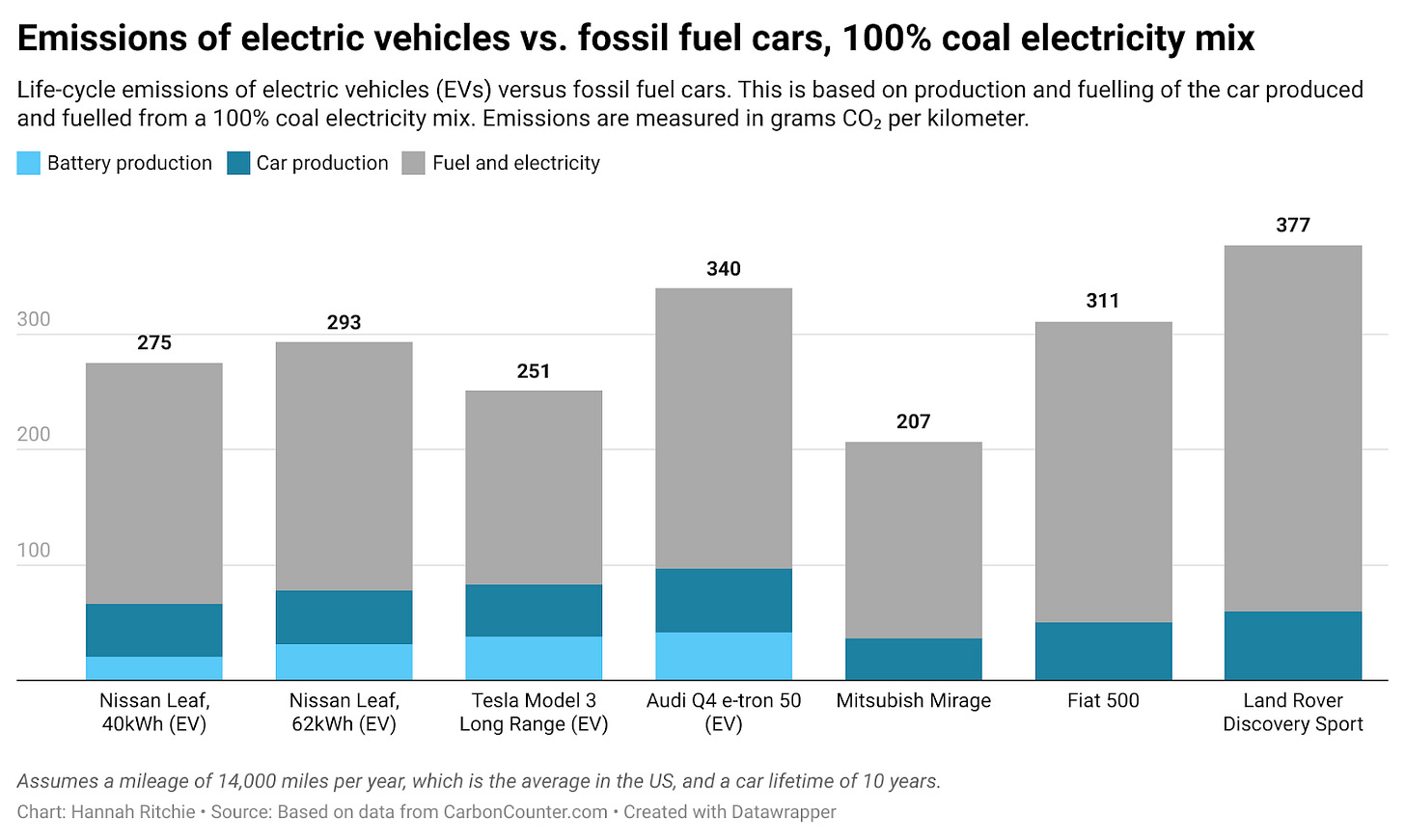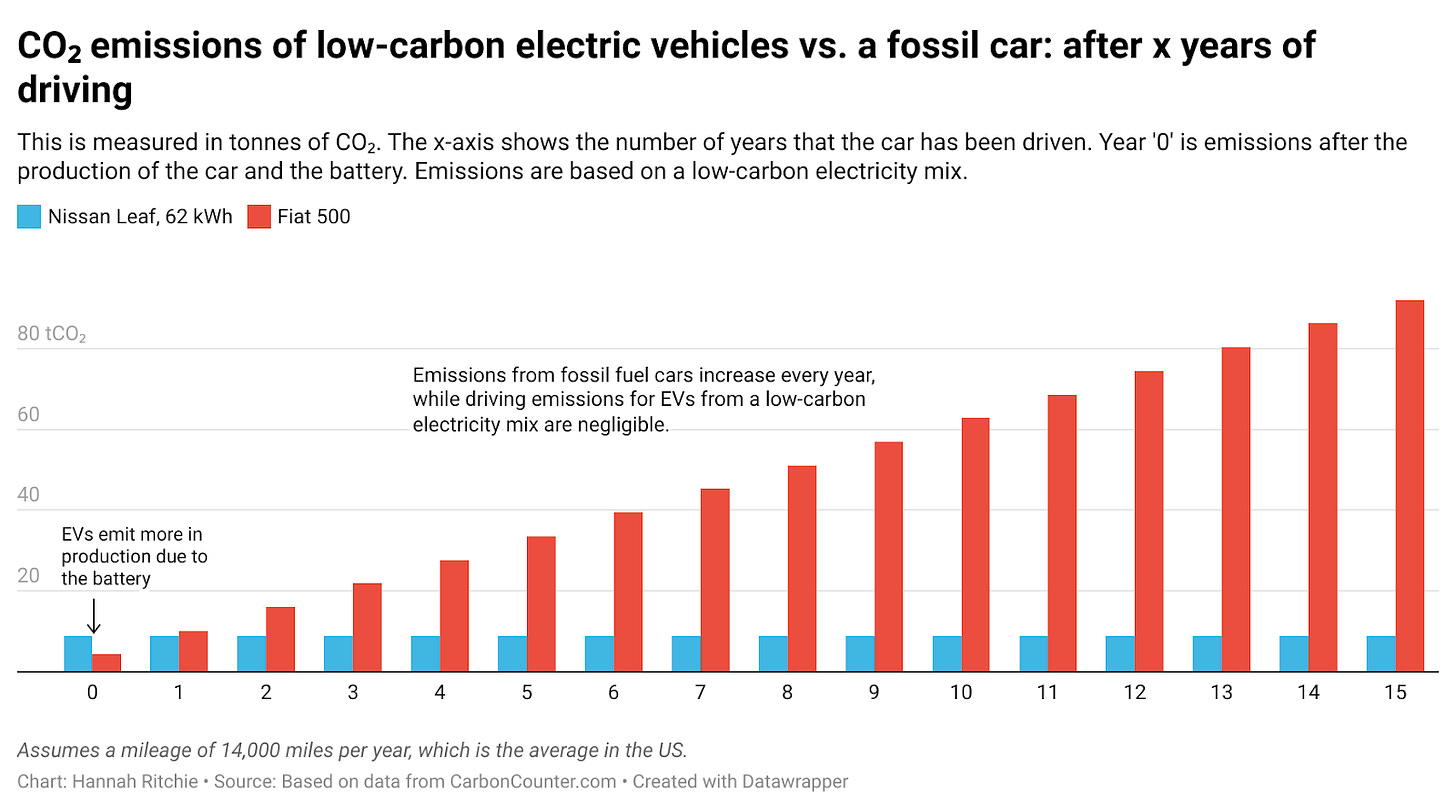Electric cars are better for the climate than petrol or diesel
Electric cars emit less CO₂ than gas cars. But to get maximum benefits, we need to decarbonise our electricity quickly.
For a more in-depth analysis of the climate impact of electric cars, I recommend Zeke Hausfather’s analysis on Carbon Brief.Electric vehicles are marketed as an important technology to reduce CO₂ emissions. But, electric vehicles (EVs) still need electricity to run, and manufacturing batteries can be energy-intensive.
These facts can make it easy for people to argue that EVs are a climate con: that they’re just as bad – if not worse – than petrol or diesel cars.
Is this true?
In this post, I crunch through all the data on the carbon footprint of EVs compared to conventional fossil cars.
The summary is that, yes, EVs emit less – often one-half to two-thirds less over their lifetime. EVs still emit less when the battery is produced in countries that rely heavily on coal.
And, this is true, regardless of whether you’re thinking about buying a new car, or a second-hand one.
As the world moves towards lower-carbon electricity, the emissions of EVs will fall even more. When run on renewables or nuclear, the footprint of EVs could be tiny.
Electric vehicles emit more during their production, but this quickly pays back once people start driving
Here I’m going to compare a range of electric and conventional fossil cars. I’ve tried to pick a fair range for each: spanning the lowest to high-footprint cars.
The data that I’m building on comes from CarbonCounter.com – this is a fantastic tool built by Marco Miotti and Jessika Trancik from the MIT Trancik Lab that lets you evaluate the carbon emissions and costs of vehicles under a range of energy and driving conditions. The methods are based on peer-reviewed research that looks at the impact of vehicles across their whole supply chain.1
When we think about the carbon footprint of vehicles we need to think about the CO₂ that’s emitted during the production of the car, and the CO₂ emitted when driving it.
We’re going to do that here. First, we’re going to compare cars with the assumption that they’re produced in the US, and that EVs are run on the country’s average electricity mix. In the chart, we see the comparison of each car, shown in grams of CO₂ per kilometre travelled.2
Focus on the blue bars to start. You can see that the sum of the battery and car production for EVs is higher than the production of a fossil fuel car. Producing an EV emits more than a petrol or diesel one.
But, when we factor in the emissions of driving, EVs are much better.
Over its lifetime, the average driver in the US could reduce emissions by half by switching to an EV.
Another way to look at this is to look at the cumulative emissions of the car, year after year. In the chart, I’ve done this for two cars: the larger (62 kWh) Nissan Leaf, and the Fiat 500, which are both mid-range cars.
The cumulative emissions are shown in tonnes of CO₂ after 1, 2, 3 years of driving, and so on. Year ‘0’ is the emissions from the production of the car alone.
By looking at year ‘0’ we see that manufacturing a battery is costly: the EV emits more than the fossil car during production.
As soon as you start driving, EVs start to pay back their carbon ‘debt’ quickly. In fact, after just two years of driving, EVs are already better. This gap grows year after year. After 10 years of driving, the Nissan Leaf would have half the emissions of the Fiat 500.
Driving an electric vehicle in Europe or California is even better
We just looked at driving an EV using the average electricity in the US. But many places have cleaner electricity.
What if we produced and ran this EV in the UK or California (which have a pretty similar carbon intensity of electricity)?3
The climate benefits are even greater. We see this comparison in the chart.
Electric vehicles are still better, even if the battery is produced from a coal-heavy electricity mix
“Electric cars are just as bad because the batteries are produced in coal-heavy China”. This is a common argument against EVs.
Let’s see if it’s true.
We’re going to imagine that the cars are produced with an electricity mix that is 100% coal. That’s much more carbon-intensive than producing it in China, which gets around 60% of its electricity from coal. But let’s just go all the way to the extreme.
Let’s then imagine that you’re a Californian (or a Brit), so the electricity is coming from the local mix.
In the chart, we see the results. There’s no contest: EVs emit much less than fossil cars, even though they emit more in their production.
However, the tables turn if the car was produced from electricity running on 100% coal and it was run on coal too. To be clear: this is an unrealistic extreme. There’s nowhere in the world where this is the case.
In the chart, we see the impact.
EVs don’t beat the most efficient conventional cars. They do have lower emissions than most mid-range cars. And they certainly emit much less than bigger gas-guzzlers.
But in a scenario where you’re running your car completely on coal, the benefits of an EV are marginal, if they exist at all. This is why decarbonising the electricity mix is so important.
EVs can get much better: if we move to low-carbon electricity, their footprint will be very small
The emissions of EVs in this article are not fixed: they will get lower over time, as the world decarbonises its electricity.
When they’re charged by a low-carbon mix of renewables and nuclear, the emissions of an EV are tiny.
In the chart, we see the new comparison, where the ‘driving’ emissions of the EVs are effectively zero.
Again, we can look at the cumulative annual emissions of the Nissan Leaf and the Fiat 500. The cumulative emissions are shown in tonnes of CO₂ after 1, 2, 3 years of driving, and so on. Year ‘0’ is the emissions from the production of the car alone.
After car production, the two trends completely diverge. The fossil fuel car continues to rise, year-after-year. Emissions from the EV do not rise at all.
EVs are also better than second-hand petrol cars
These comparisons can help us with the decision of whether to buy a new petrol car or an electric one.
But what if we go for a second-hand petrol car instead?
When we buy a second-hand car we’re avoiding the production emissions of a new one.
To see whether this is better than an EV, we assume the production emissions of the petrol car are zero. We only count the emissions from driving.
We see the comparison of the Nissan Leaf and a second-hand Fiat 500 in the chart. The Nissan Leaf is being charged with the average electricity mix in the US.
The gap at year ‘0’ is even bigger because the production emissions of the Fiat 500 are zero. The EV has a lot of catching up to do.
But, once we start driving, the gap closes quickly. After four years, an EV has paid back its carbon debt. And from then on, the Fiat 500 looks worse and worse.
If you’re charging the EV from a UK or Californian electricity mix, the ‘break-even’ point might be after 3 years instead of 4.
Buying a new EV will often result in lower emissions compared to buying a second-hand petrol car unless you only plan to drive it for a year or two, or you’re driving very little.
Conclusion: an EV is better for the climate than a petrol or diesel car
Except in the most extreme scenarios, opting for an EV is better for the climate than a petrol or diesel car. This is even true if you’re buying second-hand.
What’s important is that this gap between EVs and conventional fossil cars will get even bigger in the future. If you’re buying an EV now, its emissions 5 or 10 years from now will be even lower. As we move toward a low-carbon electricity mix, the footprint of an EV will keep shrinking.
Of course, you’re better off walking or cycling. That’s a no-brainer (even for your health and wallet). But comparing car-to-car, the EV wins almost every time.
Methodology and additional FAQs
Most of the figures presented in the charts are based on my own calculations. But the underlying data – which provides the emissions of battery, car and fuel and electricity production comes from CarbonCounter.com – this is a fantastic tool built by Marco Miotti and Jessika Trancik from the MIT Trancik Lab that lets you evaluate the carbon emissions and monetary costs of a range of vehicles under a range of energy and driving conditions.
The methods are based on peer-reviewed research that looks at the impact of vehicles across their whole supply chain.
Selection of cars
I tried to pick a range of vehicles for EVs and fossil cars, ranging from low to high emissions.
The Nissan Leaf is an efficient EV. I’ve included two versions: one with a smaller (40kWh) and larger (62kWh) battery. The Tesla Model 3 Long Range is s mid-range EV in terms of emissions. And the Audi Q4 e-tron 50 is a bigger EV, in the high-range of emissions.
For conventional fossil cars, the Mitsubishi Mirage is one of the most efficient on the market. The Fiat 500 is a mid-range car. And the Land Rover Discovery Sport is a larger car toward the high-range (although it’s still not at the top in terms of emissions).
Electricity mixes
Throughout the article I varied the source of electricity. CarbonCounter.com lets you do this, and it updates its estimated car production and driving emissions accordingly.
I looked at the most extreme scenarios: from a 100% coal electricity mix, to a zero-carbon mix. And, of course, looked at the more realistic scenarios of the US average mix, and a UK and Californian mix.
How does the driving mileage affect emissions?
For this analysis I assumed an annual driving distance of 14,000 miles. This is the average in the US.
Driving less will give slightly different figures, but does not change the overall conclusions. To test this, let’s do the comparison for the UK again, but we’ll drive 7,000 miles a year instead – that’s the average in the UK.
EVs still clearly outperform fossil cars. For most comparisons, the higher the mileage, the better an EV looks. But you need to get to very low mileage numbers for EVs not to be the better option.
How does the car's lifetime affect emissions?
In the analysis above I assumed an average car lifetime of 10 years. But some people replace their cars much earlier than this. How does that affect the result?
Well, we can look at the year-on-year comparison chart.
EVs are already better after two years of driving. So, unless someone buys a new car every few years, EVs will still come out better.
The basic principle is that the longer the lifetime of the car, the better an EV will look. But all that changes is the size of this difference. The emissions of an EV can still be much lower, even after 5 or 6 years of driving.
There is a range of estimates for the carbon intensity of battery production
Estimates of the emissions of battery production can vary a lot.
CarbonCounter.com allows you to select one of three options for the carbon intensity of battery production:
A low estimate of 52 gCO₂/kWh.
A default (median) estimate of 100 gCO₂/kWh.
A high estimate of 173 gCO₂/kWh.
In this analysis, I used the default (median) estimate throughout. But we should check whether the high estimate would change our conclusions much.
I’ve run the numbers, using the US energy mix, but with the high estimate of battery production in EVs. We can see that the gap between EVs and conventional cars gets closer, but the emissions of EVs are still lower than the most efficient petrol or diesel cars.
Miotti, M., Supran, G. J., Kim, E. J., & Trancik, J. E. (2016). Personal vehicles evaluated against climate change mitigation targets. Environmental science & technology, 50(20), 10795-10804.
For this analysis I'm assuming a travel distance of 14,000 miles (22,500 km) per year.
This is the average in the US. In other countries, this can be quite a bit lower: in the UK, for example, the average is around 7,000 miles (11,000 km).
Carboncounter.com estimate that the Californian electricity mix is around 250 grams of CO2 per kWh.
UK electricity is around 270 gCO₂/kWh – a little higher.













This is a very good analysis, however I think a few more issues should be also considered. The lifetime assumption of 10 years is good for new cars, but for older cars, depending on the age when bought the lithium ion batteries may be need to be replaced within that time, incurring the batteries manufacture hit once again. The other issue is that cost is not considered and the analysis assumes a single car. Right now a small percentage of cars is electric, but if even half of all new cars were electric then until the battery/electric motor mineral supply chain ramps up the cost of electric vehicles will go up significantly. If the goal is to reduce emissions from the current level, using batteries in hybrid vehicles ( which use a much smaller number of batteries than a full BEV) would reduce emission even more since many more of them could be produced for the same amount of money. For example replacing 50% of all existing cars with hybrids that get double the mileage of current cars would reduce the emissions by 25% the same as replacing only 25% of existing cars with fully electric ones. The problems of upgrading grids and adding charging stations is also a hidden cost, since, like it or not, the petroleum infrastructure is already fully built out.
Always thought EVs are better on a long term basis but a 2-3 years (in case of UK) payback on production emissions is awesome.